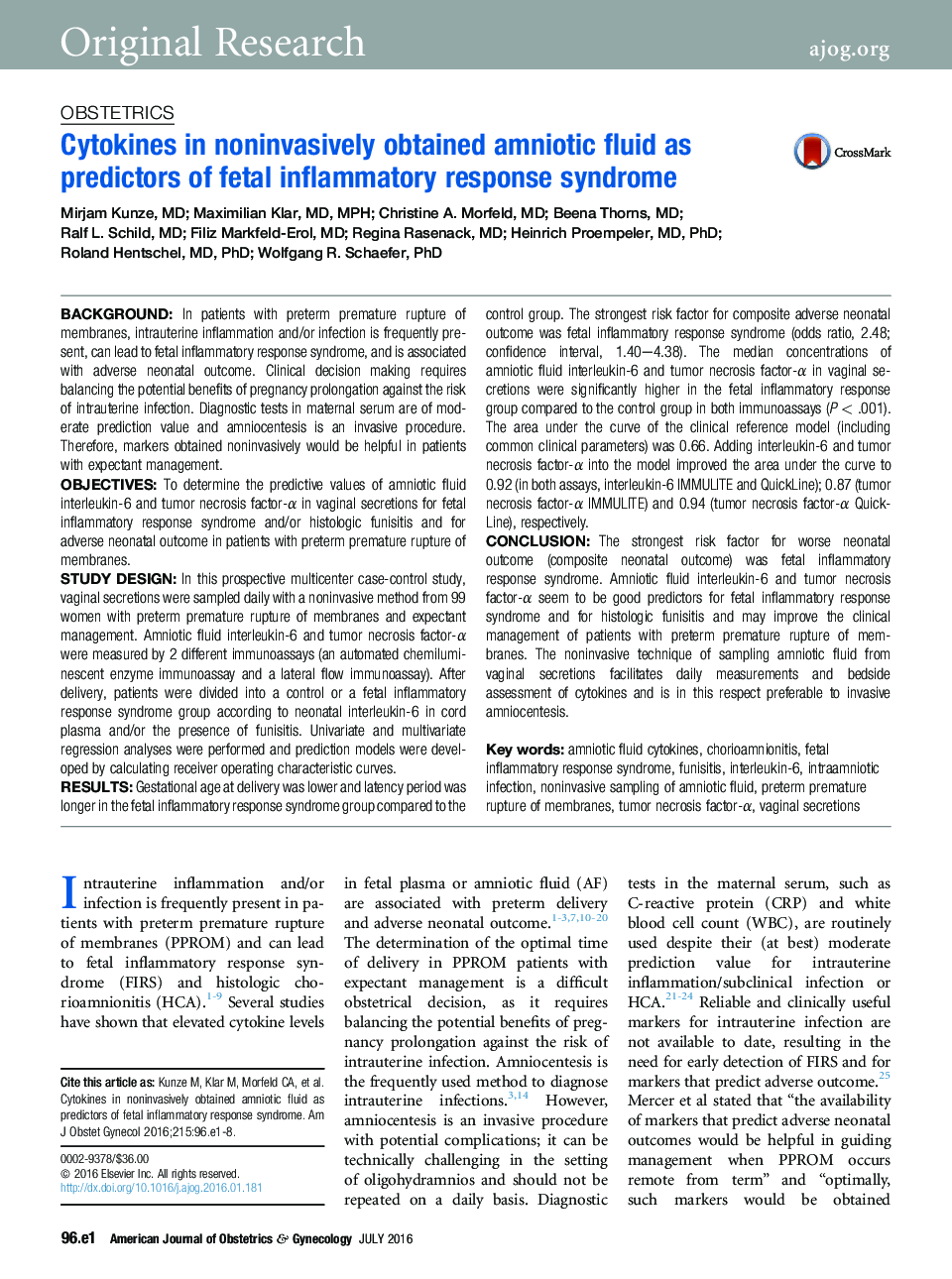| کد مقاله | کد نشریه | سال انتشار | مقاله انگلیسی | نسخه تمام متن |
|---|---|---|---|---|
| 6143775 | 1594888 | 2016 | 8 صفحه PDF | دانلود رایگان |
BackgroundIn patients with preterm premature rupture of membranes, intrauterine inflammation and/or infection is frequently present, can lead to fetal inflammatory response syndrome, and is associated with adverse neonatal outcome. Clinical decision making requires balancing the potential benefits of pregnancy prolongation against the risk of intrauterine infection. Diagnostic tests in maternal serum are of moderate prediction value and amniocentesis is an invasive procedure. Therefore, markers obtained noninvasively would be helpful in patients with expectant management.ObjectivesTo determine the predictive values of amniotic fluid interleukin-6 and tumor necrosis factor-α in vaginal secretions for fetal inflammatory response syndrome and/or histologic funisitis and for adverse neonatal outcome in patients with preterm premature rupture of membranes.Study DesignIn this prospective multicenter case-control study, vaginal secretions were sampled daily with a noninvasive method from 99 women with preterm premature rupture of membranes and expectant management. Amniotic fluid interleukin-6 and tumor necrosis factor-α were measured by 2 different immunoassays (an automated chemiluminescent enzyme immunoassay and a lateral flow immunoassay). After delivery, patients were divided into a control or a fetal inflammatory response syndrome group according to neonatal interleukin-6 in cord plasma and/or the presence of funisitis. Univariate and multivariate regression analyses were performed and prediction models were developed by calculating receiver operating characteristic curves.ResultsGestational age at delivery was lower and latency period was longer in the fetal inflammatory response syndrome group compared to the control group. The strongest risk factor for composite adverse neonatal outcome was fetal inflammatory response syndrome (odds ratio, 2.48; confidence interval, 1.40-4.38). The median concentrations of amniotic fluid interleukin-6 and tumor necrosis factor-α in vaginal secretions were significantly higher in the fetal inflammatory response group compared to the control group in both immunoassays (P < .001). The area under the curve of the clinical reference model (including common clinical parameters) was 0.66. Adding interleukin-6 and tumor necrosis factor-α into the model improved the area under the curve to 0.92 (in both assays, interleukin-6 IMMULITE and QuickLine); 0.87 (tumor necrosis factor-α IMMULITE) and 0.94 (tumor necrosis factor-α QuickLine), respectively.ConclusionThe strongest risk factor for worse neonatal outcome (composite neonatal outcome) was fetal inflammatory response syndrome. Amniotic fluid interleukin-6 and tumor necrosis factor-α seem to be good predictors for fetal inflammatory response syndrome and for histologic funisitis and may improve the clinical management of patients with preterm premature rupture of membranes. The noninvasive technique of sampling amniotic fluid from vaginal secretions facilitates daily measurements and bedside assessment of cytokines and is in this respect preferable to invasive amniocentesis.
Journal: American Journal of Obstetrics and Gynecology - Volume 215, Issue 1, July 2016, Pages 96.e1-96.e8
